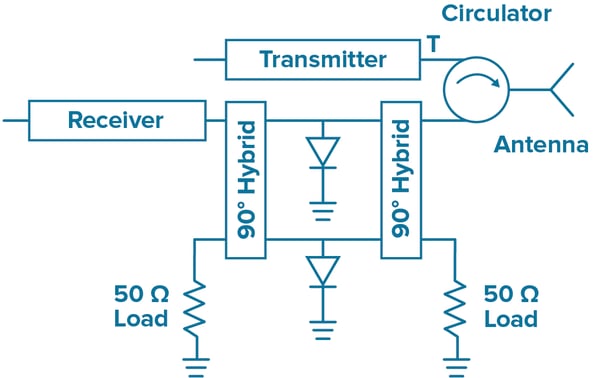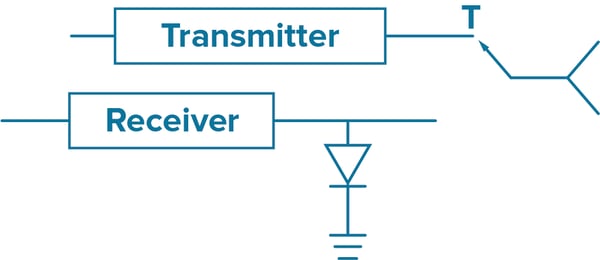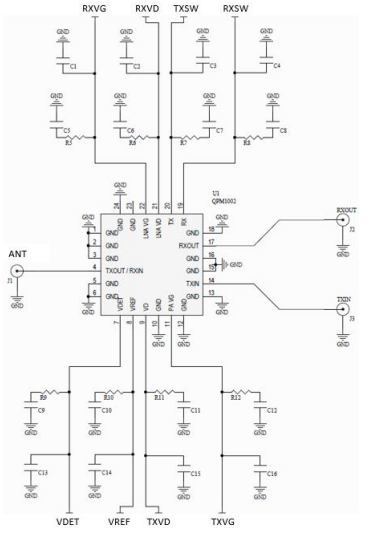This is the second installment in our RF Components for Radar series. In the first installment, we provided an overview of the key functional units in radar, including duplexing, filtering, power amplification, waveform generation, low-noise amplification (LNA), receiving and analog-to-digital conversion (ADC). Here, we’ll focus on duplexing.
There are two main approaches to duplexing in modern systems. One leverages a circulator and a hybrid coupler. The other uses a single pole double throw switch (SPDT).
Circulator and Hybrid Coupler Vs. Single Pole Double Throw Switch (SPDT)
In radar systems with a traditional Tx/Rx antenna, duplexers separate Tx/Rx signals during operation, allowing the antenna to be used for transmitting and receiving signals. This function is particularly important for maintaining performance in high-power radar systems.
Using a circulator, limiter and an SPDT switch, Tx/Rx signals can be kept separate yet connected to the same antenna.

Figure 1: Circulator and hybrid coupler duplexing scheme
In this case, the circulator directs transmit energy to the antenna and isolates the transmitter from input energy. Hybrid couplers and limiters join forces to protect the receiver by directing reflected transmit energy and unwanted input energy to a load for dissipation.
Thermal design considerations are particularly important for 90° input couplers. Excessive heat caused by power dissipation can destroy these resistors or change their resistance values. If either of these conditions occurs, the mismatched load will reflect power back into the coupler because the resistors won’t be able to terminate limiter reflections. Knowles Precision Devices tests couplers over temperature to avoid this potential pitfall.
Relying on a SPDT switch and limiter to protect the received signal requires fast, robust power switches. Here, the switch directs energy from the transmitter to the antenna and then to the receiver. The limiter helps protect the receiver.

Figure 2: SPDT duplexing scheme
T/R modules are an essential component of active electronically scanned phased arrays (AESA). These modules provide a high-power transmit path and a sensitive receive path to interface directly with a radiating element. Paths either operate using a parallel structure with elements designed to isolate and direct signals, like circulators and limiters, or using a time-multiplexed technique with solid-state switches.

Figure 3: Milestones in antenna development journey from analog to digital
The Evolution of T/R Modules and High-Power GaN RF Switches
T/R modules appeared on the scene in the 1980s. As these modules evolved alongside radar system development, beamforming best practices have too. Today, duplexing is still an important function in a digital beamforming array.

Figure 4: Duplexing is diagrammed as a circulator and takes place in each T/R module
Since they’re more widely available, gallium nitride (GaN) technology is an option for robust low-noise amplifiers, not just power amplifiers. With a GaN-LNA, there’s no need for a limiter, and with a GaN high-power SPDT switch, the circulator can be replaced with something less bulky. These changes reduce the area in the front end of the module, minimize complexity and economize assembly costs.


Figure 5: GaN-based T/R module with a circulator for duplexing (top) vs. upgrading to a switch for duplexing (bottom). Source.
Monolithic microwave integrated circuit (MMIC) devices rely on passive components, like bias networks and decoupling capacitors, to ensure proper operations. The SPDT can be integrated into a single T/R module MMIC, but more passive components are required to support additional functionality. For example, a typical T/R module requires bias and control line networks.

Figure 6: Monolithic microwave integrated circuit (MMIC) device
At Knowles Precision Devices, we have decades of experience developing high-performance passive components for electrical systems in mission-critical aerospace and defense applications. Depending on your approach to duplexing, we would support your system with hybrid couplers, bias networks or both.
Learn more about essential radar system components by downloading our ebook.


